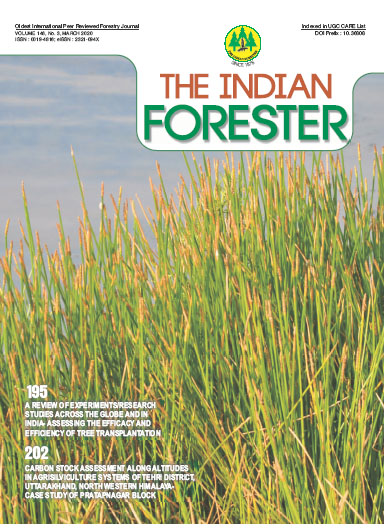Ethnomedicobotany of Different Tribals of Indo Nepal Sub Himalayan International Border Region of Pilibhit Tiger Reserve (PTR) India
DOI:
https://doi.org/10.36808/if/2020/v146i3/144348Keywords:
Ethnomedicobotany, Tribals, Indo-Nepal International Border Region, Pilibhit Tiger Reserve (PTR).Abstract
The present study deals with the detailed ethnomedico botanical observations on the usage of plants in the treatment of various human ailments by tribal and rural people of the study area. The findings are summarized as enumeration after in depth exploration of different plants used as ethnomedicines. Most of them were growing wild in the vicinity of forests of Pilibhit Tiger Reserve (PTR). Investigations were carried out during 2016-2018 in 37 tribal inhabiting localities and villages of lndo-Nepal sub Himalayan International border region of Pilibhit district of Uttar Pradesh, India. 45 plant species were recorded from the study area including 40 dicots and 05 monocots. Among them 08 species of trees, 08 of shrubs, 24 herbs, 03 grasses, 01 climber and 01 parasitic species was recorded. To maintain these natural resources, effective conservation and management practices are required.References
Dixit S.V. and Dixit G. (2008). Folk Medicinal Plants of Indo-Nepal sub Himalayan terai region of Pilibhit district of Rohilkhand Division, Uttar Pradesh. Intl. J. forUsuf. Mngt., 9(1): 65-74.
Dixit Gopal (2004). Ethnomedico botany and Human Welfare: A Graphic review and future Directions. In: Ethnomedicine in Human Welfare (I.A. Khan and A. Khanam eds.) Ukaaz Publ. Hyderabad, pp. 172 - 207.
Dixit G. (2009). Indigenous/Traditional Medicines: Challenges and Bottlenecks.In: Proceeding: ICTAM-VII, International Congress on Traditional Asian Medicine, Intl. Assn. forthe Study of Traditional Asian Medicine (IASTAM), Thimpu, Bhutan.
Dixit G. (2018). Ethnomedicinal plants used by tharu tribe of Indo Nepal sub Himalayan terai region of Rohilkhand division of Uttar Pradesh. Proceeding: 6th Natational Conference on Scientific Rationality and Socio Cultural Changes, Govt P.G. College, Bisalpur, Pilibhit, India.
Dixit G. and Vakshasya S. (2019). Ethnotherapies of various human ailments by Tharus of Indo- Nepal sub Himalayan terai International Border region of Rohilkhand division of Uttar Pradesh, India. J. Trad. Med.Clin. Res., 8(1): 1-3.
Duthie J.F. (1960). Flora of Upper Gangetic Plains and ofthe adjacent Shivaliks and sub Himalayan tracts. Repr.Ed., Botanical Survey of India, Calcutta, 2 vols.
Kirtikar K.R. and Basu B.D. (1993). The Indian Medicinal Plants. LalitMohan Basu Publ., Allahabad (Rep.Ed.).
Maheshwari J.K.; Singh K.K. and Saha S. (1980). Ethnomedicinal plants by Tharus in Kheri district, U.P. Bull. Medico-ethnobot. Res., 1: 318-337.
Maheshwari J.K.; Singh K.K. and Saha S. (1981). The ethnobotany of the tharus of Kheri district Uttar Pradesh. National Botanical Research Institute, Lucknow.
Negi V.M. and Chauhan N.S. (2009). Medicinal and Aromatic plants wealth of a tribal district Kinnaur in Himachal Himalayas. Indian Forester, 135 (6): 838-852.
Vakshasya S. (2009). Ethnobotanical studies on the tribals of Pilibhit district, Uttar Pradesh (U.P), with special reference to their socio economic upliftment. PhD thesis, M.J.P. Rohilkhand University, Bareilly, pp 317.
Vakshasya S. and Dixit G. (2011). Plants used in contact therapy by Van Gujjars and other indigenous people of Khatima Terai region of district Udham Singh Nagar of Uttarakhand State. J. Econ. Taxon. Bot., 35(2): 407-411.
Downloads
Downloads
Published
How to Cite
Issue
Section
License
Unless otherwise stated, copyright or similar rights in all materials presented on the site, including graphical images, are owned by Indian Forester.





